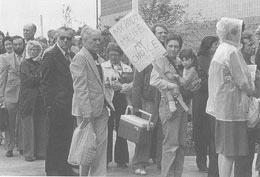On April 27, 1985, Group Health Cooperative holds its first membership meeting outside Seattle, in Tacoma Dome, and the members soundly defeat an attempt to ban abortions at Group Health facilities. The meeting has a record turnout of some 2,000 members who are met by busloads of picketers and counter-picketers who harangue members to support or oppose a resolution to repeal Group Health's performance of abortions.
Aubrey Davis, chair of the board, presided over the meeting.
Other significant actions taken included a proposed bylaw amendment to provide for mail-in ballots on all future amendments and resolutions. Former trustee Eleanor Brand sharply opposed this, feeling that the amendment would nullify the annual meeting as a forum. Such a meeting, she declared, "is the only time the membership has the authority to control the Cooperative. Mail balloting destroys this authority" (Crowley, 192). University of Washington Professor Alex Gottfried also objected, arguing that attendance at annual meetings would dwindle and voting would become more "amenable to special interests" (Crowley, 192). Despite these objections, the members passed the amendment.
The members also passed a resolution dealing with an enormous increase in Group Health's administrative costs since 1982. The members rejected a resolution mandating severe cutbacks, but directed the board to reassess the commitment to growth.
They passed another bylaw amendment replacing Group Health's district structure with Medical Center Councils, and replacing the District Council with a Medical Center Council Assembly mandated to meet four times a year.
The debate on Resolution 3, to ban abortions, was passionate but civil. It was moved and championed by Tom Wingard-Phillips. The only real fireworks came over a proposal to vote by secret ballot, which was defeated. Group health members defeated the resolution to ban abortions 1,146.5 to 293.

